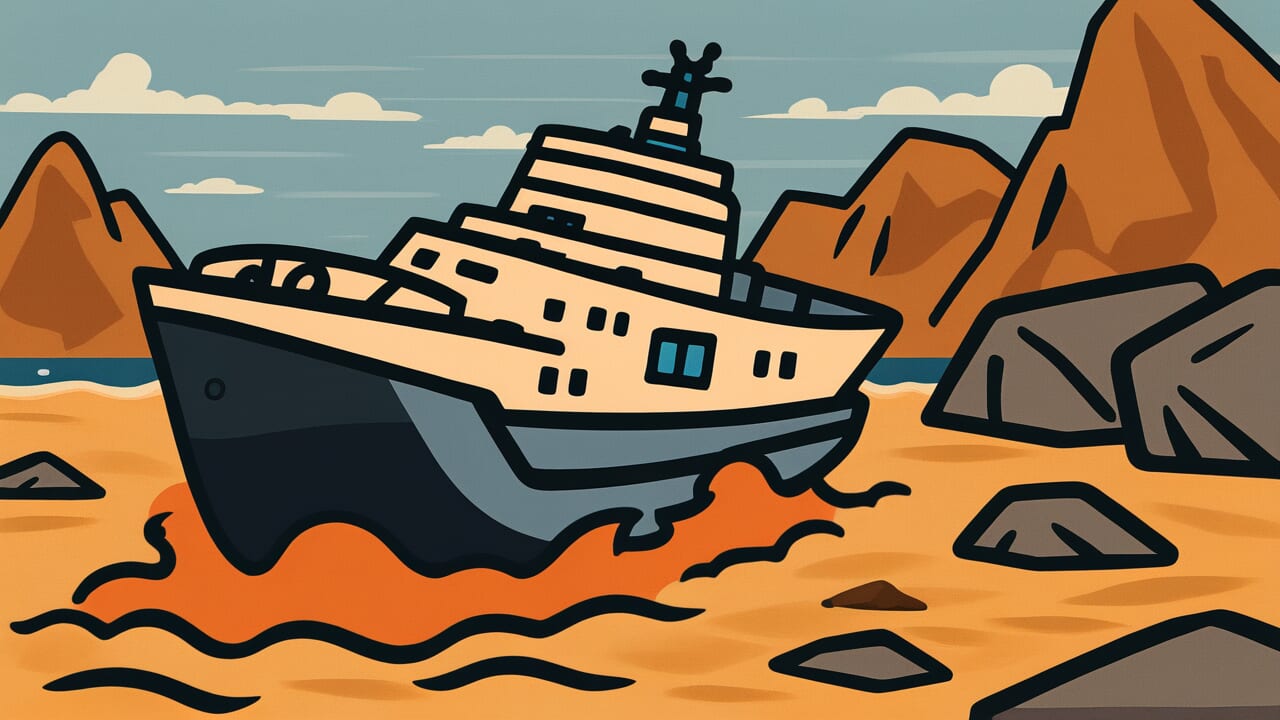How to Read “Breaking a ship at the water’s edge”
Isogiwa de fune wo yaburu
Meaning of “Breaking a ship at the water’s edge”
“Breaking a ship at the water’s edge” means failing right before reaching your goal. It describes situations where you mess up at the very last moment due to carelessness or letting your guard down, after putting in long effort.
This proverb applies to many situations. You might get sick during the final week before an important exam. You might skip the final check on a big project and fail. You might make a tiny mistake just before years of effort pay off.
People unconsciously relax when success seems certain. This proverb captures that psychological weakness perfectly.
Even today, we use this saying for last-minute failures. A sports team loses after being ahead. A job candidate gets rejected at the final interview. These “so close” moments are what this proverb describes.
It warns us that the moment right before success is actually the most dangerous time.
Origin and Etymology
The exact first written appearance of this proverb is unclear. However, the words themselves show it comes from Japan’s deep connection to the sea.
“Isogiwa” means the water’s edge where waves hit the shore. For sailors, seeing the shore after a long voyage meant they’d reached their destination. They had survived storms and rough seas. Safe land was finally right in front of them.
That moment is exactly when people let their guard down most easily.
In real sailing, the water’s edge is not safe at all. It’s actually a dangerous area with hidden shallow waters and rocks. Ships that sailed fine in deep ocean waters face much higher risk of running aground near land.
The seafloor near shore has a complex shape. Sailors who felt relieved seeing their destination sometimes stopped paying attention. Then they’d hit unexpected rocks and damage their ships.
This practical experience became a life lesson. The proverb contains the wisdom of ancestors who knew you need maximum attention when the goal comes into view.
Usage Examples
- Playing around with only one week until the exam is like breaking a ship at the water’s edge
- He was unprepared for the final presentation and broke his ship at the water’s edge
Universal Wisdom
“Breaking a ship at the water’s edge” reveals a fundamental contradiction in human psychology. The closer we get to our goal, the more relieved we feel. That relief is actually the biggest trap.
Why do people relax the moment they see the finish line? It’s because fatigue and tension built up during the long effort suddenly surface when success seems near.
The thought “I’ve got this now” unconsciously lowers our attention. Like marathon runners who collapse just before the finish line, human concentration has limits. Those limits often appear at the very end.
This proverb has been passed down for so long because this phenomenon is universal. No matter how times change or cultures differ, this trap of “final carelessness” exists as long as humans work toward goals.
Our ancestors must have witnessed countless examples of this failure. To pass this lesson to future generations, they used the concrete image of danger at sea to express this truth.
The most dangerous part of the path to success isn’t the first step. It’s actually the last step. This paradoxical truth shows the deep understanding of human nature this proverb contains.
When AI Hears This
A ship breaking at the water’s edge after a long voyage can be explained by complexity science. It’s called “simultaneous arrival at critical points.” When multiple danger factors exceed their limits at the same time, the system suddenly collapses.
Consider the ship’s accumulated fatigue. During the voyage, the ship receives impacts from waves tens of thousands of times. Materials engineering shows that metal undergoes “fatigue failure” even from forces below breaking strength if repeated.
Think of bending a wire back and forth until it suddenly snaps. Ships work the same way. The longer the voyage, the more invisible damage accumulates. This accumulated damage might reach 95 percent of the critical point.
Then environmental changes add to this. In deep ocean, wave energy disperses. But in shallow water, waves reflected from the seafloor concentrate their force on the ship’s bottom.
Physics calculates that wave energy density in shallow water becomes three to five times higher than in deep ocean.
Human attention also drops. Psychology research shows that when people see their goal, dopamine releases in the brain. This reduces danger detection ability by about 30 percent.
So three factors hit critical values simultaneously at the water’s edge: 95 percent fatigue, five times environmental load, and 70 percent attention capacity. This triggers a “phase transition.” The previously stable system instantly shifts to a collapsed state.
Like an avalanche starting with a single snowflake, that final blow causes total collapse.
Lessons for Today
This proverb teaches modern people something deeper than the simple lesson of “stay focused until the end.” It shows that different stages of the path to success require different types of attention.
In modern society, we constantly face “almost there” situations. Right before a project deadline. The final week before exams. The last stage of important negotiations.
At these times, we need to consciously observe our mental state. When you feel “I’ve got this,” treat that as a warning signal.
Specifically, when the goal comes into view, recheck your checklist. Get a third person’s perspective. Return to basics. When you’re tired, rely on systems and routines.
Use verification work, not just feelings, to ensure safety. This is the modern way to avoid breaking a ship at the water’s edge.
The moment when your effort bears fruit is almost here. That’s exactly why you need to stay careful and thorough until the very end. With the wisdom of our ancestors in your heart, take steady steps toward your goal.



Comments